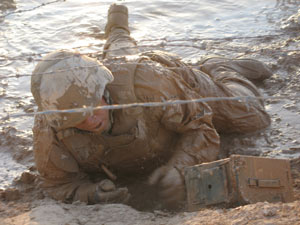Combat Stress
|
PREFACE Combat Stress is the mental, emotional or physical tension, strain, or distress resulting from exposure to combat and combat-related conditions. Controlling combat stress is a command responsibility. In terms of Service members lost from action and reduced performance, combat stress seriously affects mission accomplishment. It is a leader's responsibility to take action to strengthen Service members’ tolerance to combat stress and manage it in his or her unit. Combat stress reactions are the result of exposure to the same conditions during military actions that cause physical injury and disease in battle or its immediate aftermath, and many combat stress reactions occur in persons who are also wounded or ill with disease. Rates of combat stress casualties vary greatly, with higher ratios during lengthy periods of intense combat. In Okinawa 1945, during a peak month of battle, the combat stress casualties among Marine Forces were reported as high as one for every two wounded in action (WIA). Under less lengthy periods, as suggested by data acquired from the Israeli Defense Forces fighting in Lebanon 1982, the ratio of combat stress casualties to WIA in small units can be as high as one to one. In the past, we have generally suffered as many as one battle stress casualty for every three to five WIA in heavy fighting. However, highly trained units with strong leadership and high esprit de corps have fewer combat stress casualties. While this manual focuses on combat-induced stress reactions, it is important to emphasize that “combat stress” is not restricted only to combat, but may also arise from combat-like conditions present during military operations other than war. In an area of operations characterized by continuous action and high danger, our forces may experience high rates of stress casualties unless small-unit leaders are trained and prepared to manage stress. This publication is written to inform small-unit leaders of stress characteristics and management techniques in order to prevent, reduce, identify, and treat combat stress reactions in the Service member’s own unit to the maximum extent possible. A significant part of training is learning to control and cope with stress. Leaders must learn to cope with their own stress and then assist junior personnel in managing their stress. The application of combat stress management techniques helps conserve fighting strength and provides one more step toward achieving success.
|
TABLE OF CONTENTS Chapter 1. Combat Stress Identification 1001 INTRODUCTION 1002 HISTORY 1003 REACTIONS TO COMBAT STRESS 1004 OBSERVING AND RECOGNIZING COMMON REACTIONS TO
COMBAT STRESS 1005 SUICIDE AWARENESS Chapter 2. Combat Stress Prevention, Management, and
Control 2001 PREVENTING AND MANAGING COMBAT STRESS 2002 STRESS-REDUCTION TECHNIQUES FOR LEADERS 2003 PERFORMANCE DEGREDATION PREVENTIVE MEASURES 2004 EFFECTIVE LEADERSHIP 2005 COMBAT STRESS MANAGEMENT BUILDING BLOCKS 2006 CRITICAL EVENT DEBRIEF AND UNIT LEADER’S AFTER
ACTION REVIEW 2007 EFFECTIVE COMBAT STRESS CONTROL PROGRAM Chapter 3. Command Leadership Actions 3001 LEADERSHIP ACTIONS AND INTERVENTIONS FOR COMBAT
STRESS 3002 SAFETY CONSIDERATIONS 3003 COMBAT STRESS CASUALTY INTERVENTION MODELS Chapter 4. Sleep Deprivation 4001 CHALLENGES OF SLEEP DEPRIVATION 4002 EFFECTS OF SUSTAINED OPERATIONS ON PERFORMANCE 4003 ACHIEVING SLEEP IN COMBAT 4004 SLEEP/REST PLANNNING
|
FM 90-44/6-22.5
NTTP 1-15M
MCRP 6-11C
US Marine Corps
Home · Textbooks and Manuals · Videos · Lectures · Distance Learning · Training · Operational Safety · Search
This website is dedicated to the development and dissemination of medical information that may be useful to those who practice Operational Medicine. This website is privately-held and not connected to any governmental agency. The views expressed here are those of the authors, and unless otherwise noted, do not necessarily reflect the views of the Brookside Associates, Ltd., any governmental or private organizations. All writings, discussions, and publications on this website are unclassified.
© 2006 Medical Education Division, Brookside Associates, Ltd. All rights reserved
| Textbook 94 Pages 0.3 MB pdf Download Now |
